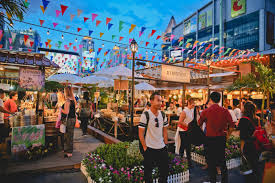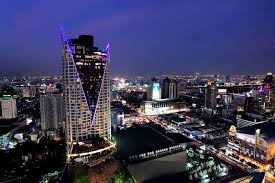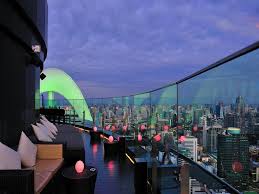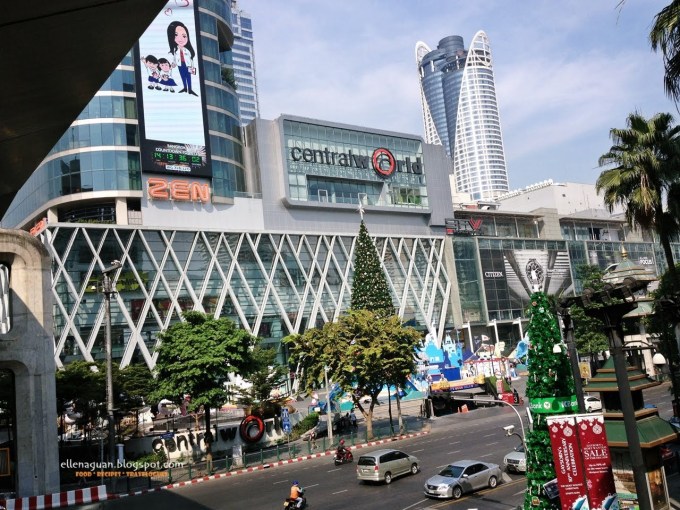Yaowarat Road in Samphanthawong district is home to Bangkok's
Chinatown, which is centred on Sam Pheng Lane Chinatown's Sam Pheng
Market is an old business centre noted for a post-WW II visit by the
young king Ananda Mahidol.Modern Chinatown now covers a large area
around Yaowarat and Charoen Krung Road. It has been the main centre for
trading by the Chinese community since they moved from their old site
some 200 years ago to make way for the construction of Wat Phra Kaew,
the Grand Palace. Nearby is the Phahurat or Indian market.


Bangkok’s Chinatown is a popular tourist attraction and a food haven for new generation gourmands who flock here after sunset to explore the vibrant street-side cuisine. At day time, it’s no less busy, as hordes of shoppers descend upon this 1-km strip and adjacent Charoenkrung Road to get a day’s worth of staple, trade gold, or pay a visit to one of the Chinese temples. Packed with market stalls, street-side restaurants and a dense concentration of gold shops, Chinatown is an experience not to miss. The energy that oozes from its endless rows of wooden shop-houses is plain contagious – it will keep you wanting to come back for more. Plan your visit during major festivals, like Chinese New Year, and you will see Bangkok Chinatown at its best.
History:-Chinatown is in one of the oldest areas of Bangkok. It is the result of the resettlement of Chinese on the west bank of Chao Phraya River after Rama I moved the capital of the kingdom from Thonburi to Rattanakosin. From there Chinese traders operated maritime junk trade between and China throughout the Rattanakosin period.By the end of 1891, King Rama V had ordered the construction of many roads, including Yaowarat Road. Chinatown does not consist of only Yaowarat Road, but also includes others such as Charoen Krung Road, Mungkorn Road, Songwat Road, Songsawat Road, and Chakkrawat Road. Yaowarat's Sam Peng Market is the center of the area. The path of the road is said to resemble a dragon's curvy body, making it an auspicious location for business. There are many shops selling gold, garments, textiles, stationery, souvenirs, second-hand parts and equipment, electric goods, computer parts, antiques, imported musical instruments and local delicacies.Land prices around Yaowarat Road have always been among the most expensive in Bangkok and Thailand due to limited land which is mostly owned by prominent Thai-Chinese families.Yaowarat is one of the oldest Chinese communities in Thailand. The story of the Chinese in Bangkok starts in the late 1700s, when poor peasants from China's Chaozhou region (in Eastern Guangdong) moved to the Grand Palace area in Rattanakosin. They came to Siam to find work in Thonburi at the other side of the Chao Phraya River (which at that time was the capital of the country). The Chinese were requested to move outside the city walls when King Rama I set up his new capital in the Grand Palace area in 1782.

The new Chinese neighbourhood, nowadays named after Yaowarat Road, became Bangkok's main centre of commerce for the following two centuries. Formerly impoverished peasants worked their way up to become the backbone of trade in Siam. It also became known as a seedy area thriving on brothels, gambling houses and opium dens, though these activities are illegal nowadays and no longer to be found in the district. The business centre of the district moved from Sampeng Lane to Yaowarat Road and Charoen Krung Road in 1891, when those roads were built by a decree of King Rama V.A few years later a fire broke out, which opened the way for the construction of Phahurat Road in 1898. King Rama V named it after his daughter Phahurat Maneemai, in remembrance of her early death at the age of ten. The area used to be an enclave of Vietnamese immigrants, who had lived here since the reign of King Taksin in the late eighteenth century. Construction of the road made way for the Indian community to move in and since then, this neighbourhood evolved its own South Asian character that persists today.As Thailand became one of Asia's emerging economies, the commercial core moved from Yaowarat and Phahurat to the Siam Square area. However, this multicultural district still shows what commercial Bangkok has been like for almost two decades.Compared to the rest of the city, this district is fairly compact and can best be explored in a full-day walking tour.

You'll
come across street markets, shop houses, gold shops, beautiful remnants
of colonial-style architecture and some interesting temples. Instead of
tramping from temple to temple, this neighbourhood is mostly about
catching a brief peek into commercial Bangkok as it has been the last
two centuries. Rushing through won't be rewarding—take your time
instead, sitting at a plastic chair and watching local traders sell
their wares. As the street markets are not targeted to foreigners, you
will find a wide array of products: ceramics, fabrics, gold, tacky
teenager ware, ant-killer chalk, Bollywood movies, ginseng roots. Who
knows what you'll end up with at the end of the day. It is best to come
during weekdays, as many stores close during the weekends. Also keep in
mind that most shops close at 17:00 after which most of the area gets
pretty much deserted .
No comments:
Post a Comment